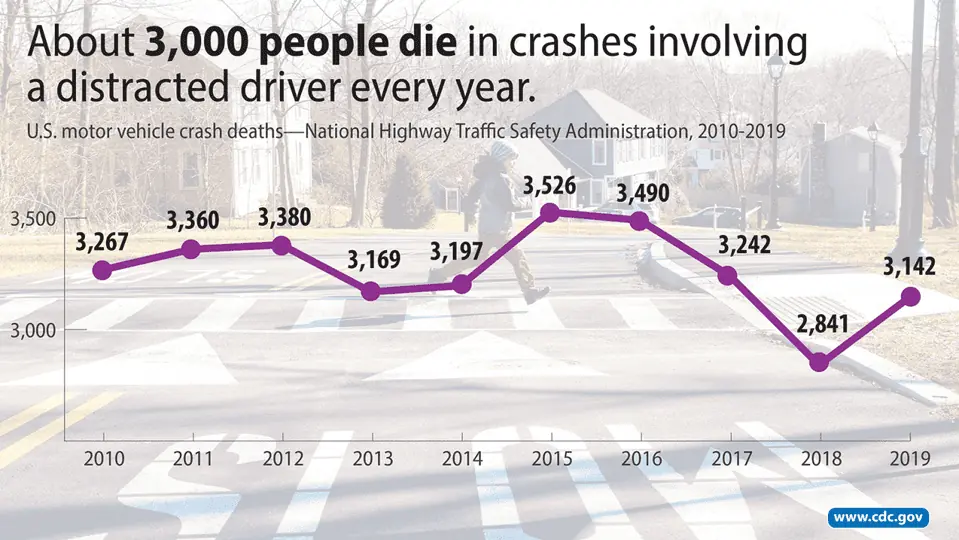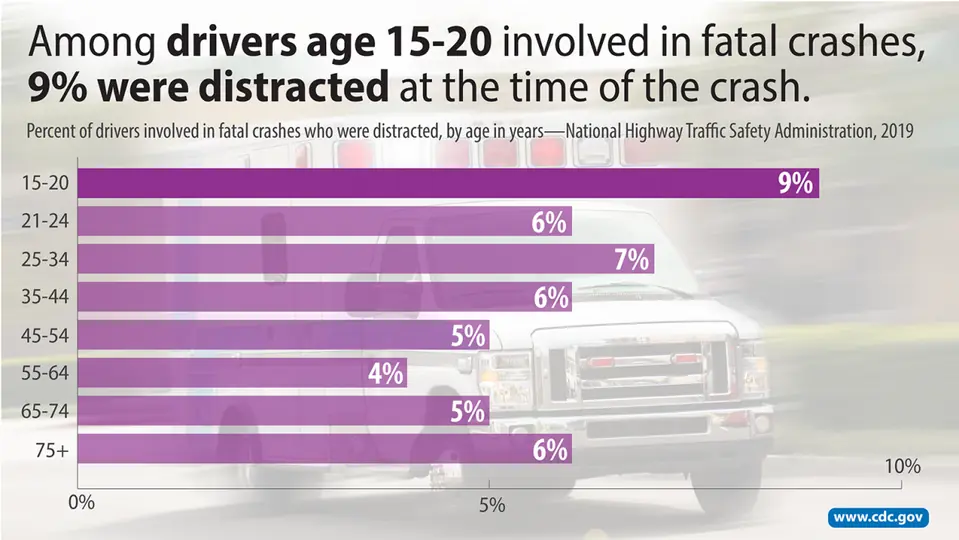Key Takeaways
- Texting while driving increases accident risk by 23 times.
- Leading cause of U.S. car crashes, claiming over 3,000 lives annually.
- Young drivers most at risk, with half considering themselves phone-addicted.
- Illegal in 49 states, with penalties ranging from fines to criminal charges.
- Why is Texting & Driving So Dangerous?
- 1. Texting Increases Your Chances of Being in an Accident
- 2. Texting While Driving Is More Dangerous Than Intoxication
- 3. Distracted Driving Is a Leading Cause of Crashes in the U.S
- 4. Distracted Driving Impacts More Than Just the Driver
- 5. Texting While Driving Has Far-Reaching Legal Consequences
- 6. Young Adults and Teen Drivers Are More Susceptible to Distracted Driving
- 7. Using Apps While Driving Can Encourage Distracted Driving
- How to Overcome Texting and Driving and Ensure Your Safety
- Frequently Asked Questions
- Wrapping Up
Why is Texting & Driving So Dangerous?
Texting while driving is one of the leading causes of road accidents that claim thousands of lives each year.
It diverts attention from the road, impairing drivers’ awareness and putting them, their passengers, and other road users at risk.
You see, texting while driving diverts a driver’s attention through three critical distractions:
- Cognitive distraction: Texting takes your concentration off the road and diverts it to your phone. This impairs your situational awareness and ability to react to objects or events on the road.
- Visual distraction: Texting makes you take your eyes off the road. Research shows that doing so, even briefly, can disorient you and put you at risk. You’ll also need some time to reorient yourself once you look up from your phone.
- Manual distractions: To text, you need to take your hand off the wheel as you use your phone.
Come along as we explore these intriguing texting and driving statistics and illuminate some ways you can make safer choices for yourself and other road users.
1. Texting Increases Your Chances of Being in an Accident
Every year, more than 3,000 people lose their lives to car accidents involving distracted drivers. Texting while driving is often a source of distraction and increases the likelihood of being involved in a motor vehicle crash by up to 23 times.
According to the National Highway Traffic Safety Administration (NHTSA), while driving at about 55 mph, the 5 seconds it takes you to read one text message is equivalent to driving the length of a football field with your eyes closed.
As such, texting while driving exponentially increases your risk of:
- Getting into a car wreck
- Going over a curb
- Weaving and leaving the road
- Crashing into a light, sign, or tree
2. Texting While Driving Is More Dangerous Than Intoxication
Driving while under the influence is another one of the leading causes of car accidents in the U.S. However, according to research, you’re six times more likely to get into a car crash when texting while driving than when intoxicated.
This is thanks to the three-pronged assault—cognitive, visual, and manual—which is estimated to impair your response time by as much as drinking four beers in a single hour would.
According to the American Automobile Association (AAA), when you take your eyes off the road while texting, it can take up to 27 seconds for your eyes to recover and reorient to the road and for the cognitive distraction to end.
Given that drivers can spend an average of 1:38 minutes on their phone per hour of driving, it’s clear why texting while driving accounts for about 8% of all fatal crashes.
Note: Men are four times more likely to drink and drive, but women text and drive more frequently.
3. Distracted Driving Is a Leading Cause of Crashes in the U.S
According to the NHTSA, distracted driving is now the leading cause of car crashes in the U.S., where most of the distractions are a result of texting while driving.
In a study by the AAA, nearly all surveyed drivers (about 93%) believed texting while driving to be extremely dangerous.
However, up to 37% of the drivers also admitted to having read a text or email while driving within the past month. Another 27% admitted to typing while driving.
Given these figures, it’s evident why NHTSA texting and driving statistics indicate that cell phone use while driving played a role in:
- 12% of distracted driving crashes that resulted in the loss of life
- 8% of distracted driving injury crashes (more than 20,000 car wrecks)
- 8% of non-fatal accidents involving a distracted driver (over 40,000 crashes)
4. Distracted Driving Impacts More Than Just the Driver

According to the NHTSA, about 3,000 people die every year in crashes involving distracted drivers, with approximately 420,000 more sustaining injuries.
However, about 1 in 5 of the people who perish in distracted driving accidents weren’t in the vehicles at the time of the crash. They were pedestrians, cyclists, and other people outside the vehicle.
5. Texting While Driving Has Far-Reaching Legal Consequences
In addition to the grievous risk to yourself, texting while driving also causes harm to other road users.
For example, over 500 pedestrians and cyclists lose their lives in distracted auto accidents, typically involving the use of a phone.
To curb texting while driving, most states have outlawed the practice and imposed penalties and fines to punish people doing the act.
The specific fines vary from state to state, but you can generally expect to pay anywhere from $20 to $500 for a standard infraction.
Some states take their distracted driving laws a step further, for example:
- Alaska classifies texting and driving as a misdemeanor criminal offense that could earn you a year behind bars and a $10,000 fine for a first-time offender.
- Oregon imposes a $1,000 fine for drivers found guilty of texting while driving. This could go as high as $2,500, along with a six-month jail term for third-time offenders.
Accidents caused while texting and driving—especially if they result in bodily injury or death—attract much stiffer penalties, including losing your driver’s license, criminal charges, and longer jail terms.
This applies to all drivers, but especially commercial drivers, whom the Federal Motor Carrier Safety Administration (FMCSA) forbids from texting while driving, lest they risk sanctions such as driver disqualification.
6. Young Adults and Teen Drivers Are More Susceptible to Distracted Driving

Around 50% of teenagers believe they have a smartphone addiction problem, with almost 80% of them checking their phones multiple times every hour.
An additional 72% of these feel the need to respond to texts right away, even when driving, leading to a lot of distracted drivers.
This is backed up by data from the NHTSA, which indicates:
- There are more distracted drivers between 15 and 20 years old than there are drivers above 21 years old.
- 9% of these young drivers were distracted at the time of the crash in all accidents involving distracted drivers in the U.S.
A 2019 study by the NHTSA also found that:
- 39% of high school students who drove within 30 days before the survey had texted while driving on at least one occasion in that time.
- Texting while driving was more common among older students.
- Students who admitted to texting while driving were also more likely to report other risky factor behaviors, including:
- Riding with a young driver who’d been drinking alcohol
- Not wearing a seat belt
- Driving after drinking alcohol
7. Using Apps While Driving Can Encourage Distracted Driving
About 41% of drivers have admitted to using an app to listen to music or a podcast while driving.
36% will access these apps at a red light or stop sign. But even more concerning is the 35% who will continue to use their phones while driving.
Additionally, many drivers now wear headphones or earbuds while driving, introducing another layer of distracted driving.
By removing your sense of hearing, you remove a vital connection to your surroundings, impairing your awareness. This could lead to dire consequences.
Most of the drivers who fall victim to this kind of distracted driving are people aged 35 and younger. However, a new segment is quickly growing—rideshare drivers.
Because of the nature of their jobs, gig workers like rideshare and delivery drivers are four times more likely to use an app while driving than other drivers.
In a survey by the Insurance Institute for Highway Safety (IIHS), David Harkey, the IIHS President, notes:
The explosion of smartphone features and services has not only created new forms of driver distraction, but also a new group of rideshare and delivery drivers whose jobs require them to interact with their phones.
How to Overcome Texting and Driving and Ensure Your Safety
Resisting the urge to text while driving might be hard, but it’s vitally important. Here are some tips to help kick the habit and ensure your safety and that of other road users:
1. Keep your phone out of reach
Put your phone on silent or airplane mode and stash it in the glove compartment. Having your phone out of sight and out of reach will reduce the temptation to grab it at the first opportunity, removing the distraction.
2. Use a concentration app
There are helpful mobile tools, such as AT&T’s Drive Mode App, which detects when you’re driving and keeps you from texting.
The app even sends out automatic responses, letting the other party know you’re driving and will get back to them as soon as possible.
These apps eliminate the urge to respond immediately and help you better focus on the road.
3. Distract yourself
Safe distractions such as an interesting radio show or an audiobook are a great option to keep your mind off texting. These are engaging but not as distracting as texting, which takes your attention and eyes off the road.
Frequently Asked Questions
Is Texting and Driving Illegal?
Yes. Forty-nine of the fifty states have banned texting while driving for all drivers. The penalty for breaking this law ranges from a cash fine or ticket to criminal charges, depending on the severity of your infraction.
How Many Fatal Crashes Result From Texting While Driving?
NHTSA statistics tell us that approximately 3,500 people die every year from distracted-related accidents. In about 400 of these accidents, a cell phone was being used at the time of the crash.
Will Texting and Driving Impact My Car Insurance Rates?
Yes. Insurers across the U.S. penalize distracted drivers. Getting caught texting while driving will raise your insurance rate by about 21% on average but as much as 45% in some states. This rate can double with subsequent offenses.
Wrapping Up
Distracted driving, especially texting while driving, puts you and other road users at great risk.
From the statistics above, it’s clear to see why overcoming the urge to use your cell phone while on the road is vitally important.
However, this might not be feasible if you’re a rideshare or delivery driver. But that need not spell doom. With the right information and vigilance, you can make your living while staying safe on the roads.





